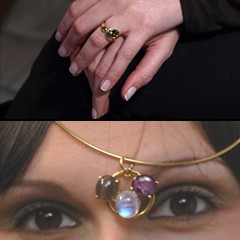
Gemstones are constructions of light. The faceted gems play with the internal reflections to give glows and flashes and sparks, while the cabochon aim to collect light instead of dispersing it. Once collected, this light can be returned to the outside in various ways, the most curious of which is the asterism phenomenon. A certain number of cabochons, if illuminated by a single light source, show a bright star with six rays that move on its surface. The reason for this is not entirely clear. Apparently this depends on microscopic uniaxial inclusions of rutile crystals that axle light into preferential aisles. But many stones are full of rutile and do not have the star; others are clear, some are cloudy and have a beautiful star. In some samples the star is superficial, and in others, the bright lines resemble blades that cross the gem. Another curious phenomenon is that, often, the star emerges a few millimeters from the surface of the stone, and this involves serious difficulties for those who want to take a picture: either you focus on the star, or on the stone. Moreover, the star is moving, with each movement of the stone, in the opposite direction to what you’d expect, because the phenomenon depends on causes internal to the crystal structure.
What you go after in precious stones the absence of inclusions (“clarity”) of the crystal. This is due to a sort of “cultural relegation” of the advice that you have been imparted on diamond: the current prelation wants it without visible signs at ten magnifications. A stone can also be very stupendous if it has some visible inclusions in it. In star sapphires, the main subject is the star; its color is secondary, and in fine the cleanness of the stone. This is admirable, because it helps in the appreciation of the object for the emotions it can instigate, and not for how much that same object gets close to whatever imposed mass appeal. The star sapphire, also in this respect, is a phenomenal gem; there are no two that are alike, but each gem has its own personality and its own story to tell. If the stone is clear, it impresses for its liquid character; if it is cloudy, it is unclear how it can pour forth such gleaming light rays from that gray; if it is transparent with ostentatious inclusions, it seems as if sun filters through the clouds with the rays that cross the horizon in a glittering sky.
In any case, all these feelings are experienced with spirituality; these are not stones to show off, but to partake. Usually they seem quiescent cabochons, but just a ray of light is needed to light them up with magic. The star sapphire is the first choice stone for those who want something beyond the diamond, emerald, sapphire and ruby. Its value is very variable; with very little you can have a nice stone, until you get to dizzying prices for the most important samples. There are, of course, also synthetic star sapphires and rubies, but any gemological laboratory is able to dissolve your doubts.
The issue gets complicated regarding color. If you take a corundum inside which there is the rutile, and is heated to high temperatures (a few degrees less than the melting point), the rutile spreads and the stone becomes much more blue than it was before. By doing so, you lose the star, so, until a few years ago, it was easy to discern: if there is the star, the color is natural! Then, the following discovery was made: if, during the cooling phase, the stone was left for a certain period of time at the recrystallization temperature of rutile (about 1.600°C), the star was reformed, without loss in the new chromatic intensity!
You will notice at this point how difficult it becomes to determine whether the stone has a natural color and star, or if they have been intensified in the lab. All the above is true for the most important stones, of a rare deep blue hue, transparent and without signs; for such stones it is worth to apply for a certificate of authenticity by a qualified lab.
For other stones, be assured; though there may be many marks, cloudlike shapes, wings of flies, diffuse haziness, garish streaks of color, visible crystals within the stone, this gem would explode if it were treated at high temperatures, so it is frankly a natural stone with a natural color, with a natural star, with the signs, the inclusions, color zoning, the characteristics that make that gem something unique in the world, its personality, that touch of charm that made you choose it among many others, all decidedly singular, unrepeatable and natural! And, although we are dealing with unique and winsome stones, they do not cost too much either.
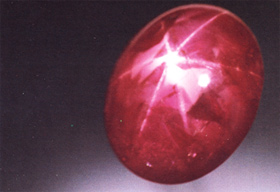
Sapphires love to play with light. Some samples are blue in natural light, and become purple in artificial light. When this phenomenon is joined to the star, the game gets really exciting. There exist (the most unique and rare) some gems that, blue in incident light, turn red if you look at the backlight. But the ability to play with light goes beyond just aesthetic aspects for sapphires. If we take a massive Indian ruby crystal, we see it smooth, opaque, with the typical form of the double hexagonal pyramid.
If you round an edge and polish it, at times a faint star will be seen. This means that the smooth pebble knows how to play with light. And, if it can play with the luminous radiation visible to us, it will be able to channel, direct, and amplify also other types of non-visible radiation. It’s now a few thousand years that the massive Indian ruby crystals are so processed to obtain “massaging stones” used in Ayurvedic medicine. They are very evocative rocks, dense with a poignant appeal that goes far beyond their modest cost. They are used on chakras, along acupuncture meridians, as ”aura activators“. Star sapphires and rubies are excellent for both state-of-the-art jewelry and traditional, for women and men. They are also great for scopes other than jewelry, and are among the most distinct existent stones in the whole world.
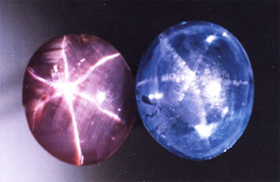
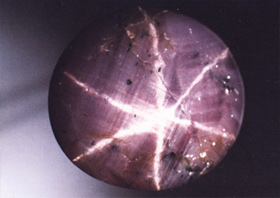
The six-rays star appears because of certain optical tensions within the crystal which, we recall, is a hexahedral prism or pyramid. Very rarely, there exist tensions within the tensions, and the star appears to have twelve rays. These are examples of great rarity and of high-profile collecting, hard to find even in the picture!
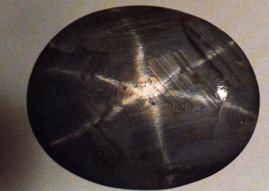
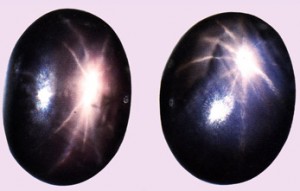
There are two occasions when you can see the sun with the stars. In rare moments of an eclipse, and when the sun illuminates rare sapphires and star rubies. This has inspired complex mythologies and legends, I tried to translate a poem, where star sapphires are the fruit of the love of a star and a ray of sunshine in a magic moment of an eclipse.
Photo captions:
The crystalline formation highlights two stars: a fixed one and a bright mobile one. These two samples are layers obtained from a single crystal and they weigh more than 100 carats. Burma star ruby of about 7 ct. Due to the funny terminology on colors, we are here facing the famous “pigeon blood”. Star ruby and sapphire couple. Origin: Sri Lanka. A very much ‘included’ star ruby with a particularly obvious star. These stones are sought for magical purposes. Star sapphire of approximately 50 ct. Note the hexagonal design, a feature of the corundum family. In this stone the star is visibly detached from the stone. Amazing pair of ruby and star sapphire with 12 rays.
Specifications of the star Sapphire
Those for the corundum are valid here.
Corundum (Al2O3), crystallizes in the trigonal system, generally with a double hexagonal pyramid shape. Its hardness, 9,0 (Mohs), although much lower than that of diamond, is among the hardest materials on earth. It can express itself in red (and will be called ruby), in blue (called sapphire), and in yellow (pudmaraga or yellow sapphire). It can also be orange (padparaska or orange sapphire), violet, gray, green, brownish. The colorless variety is also called “leucosapphire”. Certain stones, worked as cabochons, show the pleasant star phenomenon: these are the star sapphires and star rubies. Specific weight: 3.99 =; Refractive index: = 1760-1768; Birefringence: 0.008 =. Origin: Sri Lanka (Ceylon), Australia, Burma, Kashmir, Kenya, Montana, Siam. The deposits are generally alluvial. Ceylon sapphires are said to be clear, Australian ones are very dark, those form Kashmir are a dream and so on and so forth. Unfortunately it is not so simple, because there is clear and dark, good and bad material in all quarries, and very often it is not at all easy to establish the origin of the gem. Warning: Sapphires and rubies are precious stones par excellence, and research of synthetic materials that are very similar have produced stones that can be misleading. Furthermore, natural corundum lends itself to be manipulated in the laboratory: its color fr eg can be changed with heat treatments, radiation and other sorts of contraptions. The most routine practice is that of transforming the “Gheuda” (milky bluish-white sapphires) in sapphires of a nice blue color, or blackish ones into sapphires of a dark blue color.










